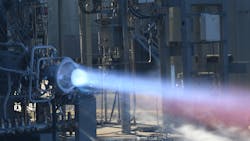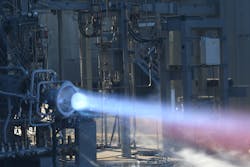NASA Uses 3D Printing to Bring the Cost of Space Exploration Down to Earth
NASA recently hot-fire tested a pair of 3D-printed components designed for rocket engines, a combustion chamber and nozzle. They are 3D printed out of a high-strength, hydrogen-resistant alloy and should withstand the combustion environments that until now only traditionally manufactured metal structures were able to.
The high-strength iron-nickel superalloy nozzle was printed using a method called laser powder directed energy deposition, which deposits and melts the metal powder to create freeform structures. This method let NASA turn out small- and large-scale components.
The components were put through 23 hot-fire tests, a total of 280 sec., over 10 test days. Throughout the testing, engineers collected pressure and temperature data in coolant channels and the main chamber, as well as took high-speed and high-resolution video of the exhaust plume and chamber throat. The team also calculated the chamber’s performance and how efficiently the engine used propellant.
The tests were a part of NASA’s Long-Life Additive Manufacturing Assembly (LLAMA) project, which aims to make 3D printed parts and hardware for future lunar landers.
“This 3D printed technology is a game-changer when it comes to reducing total hardware manufacturing time and cost,” says Tom Teasley, a test engineer at NASA’s Marshall Space Flight Center. “These hot-fire tests are critical in preparing this hardware for use in future Moon and Mars missions.”

